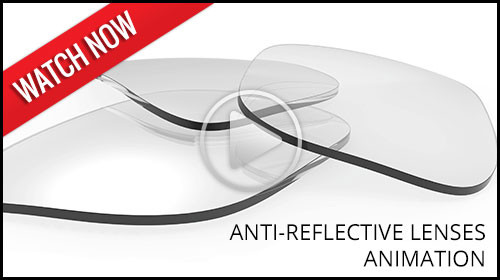Clean. Clear. Crizal®
 Crizal offers a full range of No-Glare lenses for the clearest vision possible and the most comprehensive daily UV protection1. Plus, Crizal lenses have been granted the prestigious Good Housekeeping Seal as a symbol of consumer trust and satisfaction.
Crizal offers a full range of No-Glare lenses for the clearest vision possible and the most comprehensive daily UV protection1. Plus, Crizal lenses have been granted the prestigious Good Housekeeping Seal as a symbol of consumer trust and satisfaction.
Crizal Prevencia lenses help protect your eyes from harmful Blue-Violet light in everyday surroundings including sunlight, indoor lighting, and most digital screens.
Normal eyewear often creates glare, reflections, and “ghost images.” Now all that can be eliminated with an anti-reflective treatments. What we see is a result of light being sensed by our eyes. With normal glasses, much of the light reflects off the lenses. This produces glare. It also reduces the wearer’s visual acuity. In other words, the light reflection is both a cosmetic and visual problem.
Anti-Reflective Coating
 Normal eyewear often creates glare, reflections, and “ghost images.” Now all that can be eliminated with an anti-reflective treatments.
Normal eyewear often creates glare, reflections, and “ghost images.” Now all that can be eliminated with an anti-reflective treatments.
What we see is a result of light being sensed by our eyes. With normal glasses, much of the light reflects off the lenses. This produces glare. It also reduces the wearer’s visual acuity. In other words, the light reflection is both a cosmetic and visual problem.
Anti-reflective treatments increase light transmission through the lenses to 99.5 percent. They make it easier to see and easier for others to see you. These patented treatments are especially useful for those viewing computer screens and driving at night, and our Avance with Scotchgard provides an outstanding surface protection and superb ease of cleaning not achieved by any other product
Bifocal Lenses
For many people, different lenses are needed for seeing at different distances. Bifocal lenses allow the wearer to look through two areas of the lens. One area focuses on distant objects, the other is used for reading. A little-known fact is that bifocals were invented by Benjamin Franklin, and his style of bifocals are still available today.
Most of the time the “reading” area is smaller, shaped like a sideways “D”, and found in the lower portion of the lens. These bifocals are called lined bifocals or flat-tops. If you are focusing on distant objects, you look through the top half of the lenses. To read a book, magazine, or newspaper, you look through the lower “reading” area. The Franklin style lenses are less common, and are split horizontally across the middle of each lens. One thing that can be difficult about using bifocals is dealing with the line between the two vision areas. Fortunately, recent technologies have developed a new type of lens, called the no-line, or progressive, lens.
Cosmetic & Specialty Tints
Eyeglasses can be a stylish accessory, a part of your personality, or a way for you to be unique. There are a variety of frames to choose from, but you may not know that there are also many ways to improve the appearance of the lenses, too. Cosmetic tints are now available. These tints offer a variety of colors and shades. You can choose light blue or any other color of the rainbow. Some lenses are clear at the bottom and gradually get more colored towards the top of the lenses. There are many ways to adjust your lenses to whatever style suits your personality. Some tints are also functional.High Index Lenses
Years ago,, the only materials available for use as lenses were glass and a hard resin called CR-39. More recently, high index lenses have become available. High index materials are named because they have a higher index of light refraction. Basically, they can do the same job that glass or CR-39 does, but high index lenses are much thinner and lighter. With high index lenses, you can avoid having “soda bottle” lenses.
- Polycarbonate: The first and still most popular high index material is polycarbonate. Polycarbonate was originally developed for fighter jet cockpits. It is light, and very resistant to impact. Most sports lenses are made of polycarbonate.
- Mid-Index: High index materials are classified by numbers. The higher the number, the thinner and lighter the lens. The lower numbers are classified as mid-index lenses. Mid-index lenses, such as 1.54, 1.56, and 1.57, are thinner than glass (1.53), and nearly as strong as CR-39 plastic (1.49).
- High-Index: High index lenses, such as 1.60, 1.66, 1.70, and 1.71, are much thinner than regular glass or plastic. Talk with our trained optician to decide which high index lens is right for you.
Progressive/Multifocal Lenses
 One of the main problems with bifocal and trifocal (multi-focal) lenses is that the lines separating the various focal ranges are visible to the wearer, and often cause images to "jump".
One of the main problems with bifocal and trifocal (multi-focal) lenses is that the lines separating the various focal ranges are visible to the wearer, and often cause images to "jump".
A substancial improvement to progressives are the Varilux family of multifocal lenses. Varilux is the industry leader in multifocal lenses created for the unique needs of each wearer. From the Ipseo, Physio and Physio Enhanced, to the Definity, Definity Short, and the New Comfort, Varilux has the lens for you!!
An improvement in multifocal design is the no-line or progressive lens. No-lines provide a smooth transition from focusing on nearby to focusing on distant objects because they do not have a distinct line which separates the focusing powers. Instead, a gradual change in power allows the wearer to focus on objects at all distances. Distant objects are viewed through the upper portion of the lens, while near objects are viewed through the middle or lower portion of the lens. These are also great for computer users.
Photochromics (Lenses darken with sunlight)
If you have ever felt frustrated at needing both prescription glasses and prescription sunglasses to accommodate an outdoor lifestyle, you should consider photochromic lenses. Photochromic lenses darken when exposed to UV rays. The change is caused by special molecules that are found throughout the lens or in a coating on the front of the lens. When the wearer goes outside, the lenses darken or tint. When the wearer goes back inside, the lenses become clear again.
There are a variety of photochromic options available with choices in color or darkness of tint. An important fact about photochromic lenses is that they do not darken as fully when worn while driving a car, because the windshield absorbs much of the UV light required to activate the lens.
Transitions
 When Transitions® lenses are exposed to UV light, trillions of photochromic molecules in the lens begin to change structure. This reaction is what causes the lenses to darken.
When Transitions® lenses are exposed to UV light, trillions of photochromic molecules in the lens begin to change structure. This reaction is what causes the lenses to darken.
All lenses that adapt to light use photochromic molecules; the superiority of Transitions brand technology lies in our exclusive, patented formulas. Each formula is integrated into the surface of the lens. These molecules constantly and smoothly recalibrate so the optimal amount of light reaches your eyes whether you’re in bright sunlight, under cloud cover or indoors.
Polarized Lenses
 Glare from wet roads, light reflecting off other vehicles, and glare from your own windshield can be annoying and dangerous. To eliminate this glare, we offer polarized lenses. Polarized lenses significantly reduce glare, decreasing eye strain and increasing visibility. Polarized lenses are the most effective way to reduce glare.
Glare from wet roads, light reflecting off other vehicles, and glare from your own windshield can be annoying and dangerous. To eliminate this glare, we offer polarized lenses. Polarized lenses significantly reduce glare, decreasing eye strain and increasing visibility. Polarized lenses are the most effective way to reduce glare.
Most glare comes from horizontal surfaces, so the light is "horizontally polarized." Polarized lenses feature vertically-oriented "polarizers." These polarizers block the horizontally-polarized light. The result is a glare-reduced view of the world. Polarized lenses can make a world of difference for any outdoor enthusiast. Fishermen can eliminate bright reflections from the water and actually see into the water more easily than with any other sunglasses. Golfers can see the green easier, and joggers and bikers can enjoy reduced glare from the road. In addition, drivers can enjoy the safety and comfort that polarized lenses provide while driving.
Scratch Resistant Coating
If you chose hard resin lenses, including high index, you should consider getting a scratch resistant coating. Resins and plastics are more susceptible to scratches than glass. Scratches damage the cosmetic look of the lenses and compromise their performance. With a scratch resistant coating, you do not have to worry as much about minor scratches on your lenses. Another advantage of scratch resistant coatings is that most coatings come with a one-year warranty. They are a great investment to prevent minor scratches. However, it is important to remember that scratch resistant does not mean scratch-proof. All lenses are susceptible to scratches.
but the surface treatments included with Avance and Sapphire offer a level of protection and guarantee that stands alone in the industry.
Specialty Lenses
 We all have heard the phrase, "Different strokes for different folks." Well, this holds true in terms of selecting glasses. There are different lenses for just about everybody. No matter what your particular need, there's probably a specialty lens designed for you.
We all have heard the phrase, "Different strokes for different folks." Well, this holds true in terms of selecting glasses. There are different lenses for just about everybody. No matter what your particular need, there's probably a specialty lens designed for you.
For example, a specialty lens that is becoming increasingly useful is designed for computer users. Computer lenses have "windows" designed for viewing your computer screen, documents on your desk, the keyboard, and near objects for reading. The lenses are designed to reduce Computer Vision Syndrome, or CVS, which is characterized by headaches, eye strain, neck and back aches, dry eyes, blurred vision, and double vision.
Another example is called the double D-segment lens, also known as the double flat-top lens. If you look through the center portion of the lens, you can focus on distant objects. But you can also look through a D-shaped segment near the top of the lens to see nearby overhead objects more clearly. This is very useful if you are involved in work where you're looking at nearby objects above your field of vision, as with carpenters and pilots. The D-shaped segment near the bottom of the lens allows for reading.
Trifocal Lenses
Bifocals allow the wearer to read through one area of the lens, and to focus on distant objects through another area of the lens. As the eyes age, though, a stronger prescription is needed to read. As the bifocal power increases, the range of focus with it becomes more shallow, making it difficult to focus on objects at middle distances, such as grocery items on a shelf or your speedometer. Thus, trifocals are necessary for a third prescription for intermediate focusing.
Trifocals, also known as line trifocals, feature three areas of focusing power, each separated from the other by a distinct line. The three windows allow for focusing on distant objects, intermediately distanced objects, and for reading. The downside of trifocals is dealing with the lines between the different focusing powers. The advantage of this design is that the intermediate and near sections are wider than those of progressive lenses.


